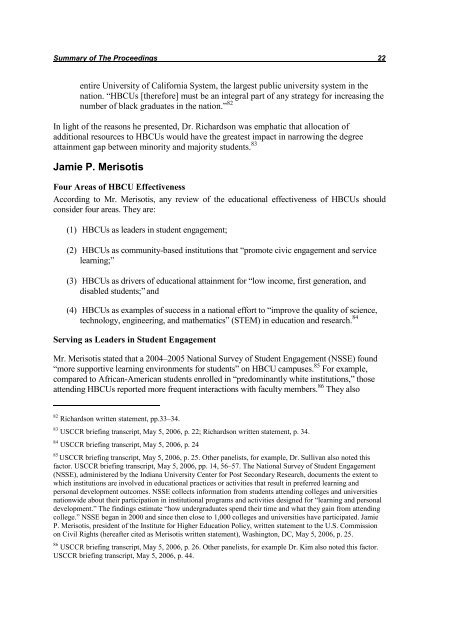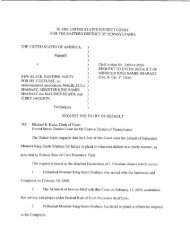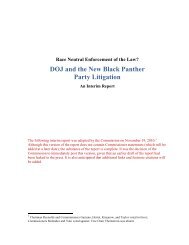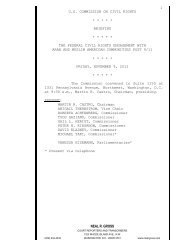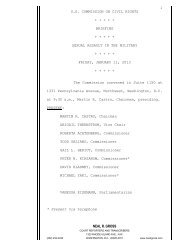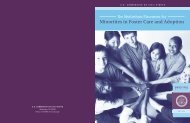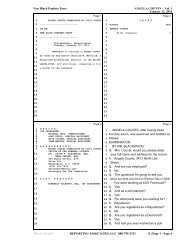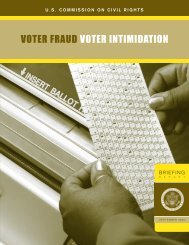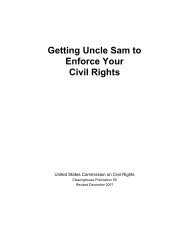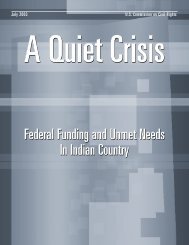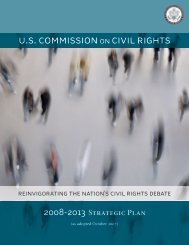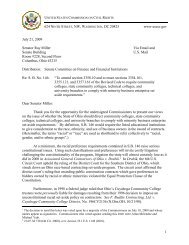The Educational Effectiveness of Historically Black Colleges and ...
The Educational Effectiveness of Historically Black Colleges and ...
The Educational Effectiveness of Historically Black Colleges and ...
Create successful ePaper yourself
Turn your PDF publications into a flip-book with our unique Google optimized e-Paper software.
Summary <strong>of</strong> <strong>The</strong> Proceedings 22<br />
entire University <strong>of</strong> California System, the largest public university system in the<br />
nation. “HBCUs [therefore] must be an integral part <strong>of</strong> any strategy for increasing the<br />
number <strong>of</strong> black graduates in the nation.” 82<br />
In light <strong>of</strong> the reasons he presented, Dr. Richardson was emphatic that allocation <strong>of</strong><br />
additional resources to HBCUs would have the greatest impact in narrowing the degree<br />
attainment gap between minority <strong>and</strong> majority students. 83<br />
Jamie P. Merisotis<br />
Four Areas <strong>of</strong> HBCU <strong>Effectiveness</strong><br />
According to Mr. Merisotis, any review <strong>of</strong> the educational effectiveness <strong>of</strong> HBCUs should<br />
consider four areas. <strong>The</strong>y are:<br />
(1) HBCUs as leaders in student engagement;<br />
(2) HBCUs as community-based institutions that “promote civic engagement <strong>and</strong> service<br />
learning;”<br />
(3) HBCUs as drivers <strong>of</strong> educational attainment for “low income, first generation, <strong>and</strong><br />
disabled students;” <strong>and</strong><br />
(4) HBCUs as examples <strong>of</strong> success in a national effort to “improve the quality <strong>of</strong> science,<br />
technology, engineering, <strong>and</strong> mathematics” (STEM) in education <strong>and</strong> research. 84<br />
Serving as Leaders in Student Engagement<br />
Mr. Merisotis stated that a 2004–2005 National Survey <strong>of</strong> Student Engagement (NSSE) found<br />
“more supportive learning environments for students” on HBCU campuses. 85 For example,<br />
compared to African-American students enrolled in “predominantly white institutions,” those<br />
attending HBCUs reported more frequent interactions with faculty members. 86 <strong>The</strong>y also<br />
82 Richardson written statement, pp.33–34.<br />
83 USCCR briefing transcript, May 5, 2006, p. 22; Richardson written statement, p. 34.<br />
84 USCCR briefing transcript, May 5, 2006, p. 24<br />
85 USCCR briefing transcript, May 5, 2006, p. 25. Other panelists, for example, Dr. Sullivan also noted this<br />
factor. USCCR briefing transcript, May 5, 2006, pp. 14, 56–57. <strong>The</strong> National Survey <strong>of</strong> Student Engagement<br />
(NSSE), administered by the Indiana University Center for Post Secondary Research, documents the extent to<br />
which institutions are involved in educational practices or activities that result in preferred learning <strong>and</strong><br />
personal development outcomes. NSSE collects information from students attending colleges <strong>and</strong> universities<br />
nationwide about their participation in institutional programs <strong>and</strong> activities designed for “learning <strong>and</strong> personal<br />
development.” <strong>The</strong> findings estimate “how undergraduates spend their time <strong>and</strong> what they gain from attending<br />
college.” NSSE began in 2000 <strong>and</strong> since then close to 1,000 colleges <strong>and</strong> universities have participated. Jamie<br />
P. Merisotis, president <strong>of</strong> the Institute for Higher Education Policy, written statement to the U.S. Commission<br />
on Civil Rights (hereafter cited as Merisotis written statement), Washington, DC, May 5, 2006, p. 25.<br />
86 USCCR briefing transcript, May 5, 2006, p. 26. Other panelists, for example Dr. Kim also noted this factor.<br />
USCCR briefing transcript, May 5, 2006, p. 44.


